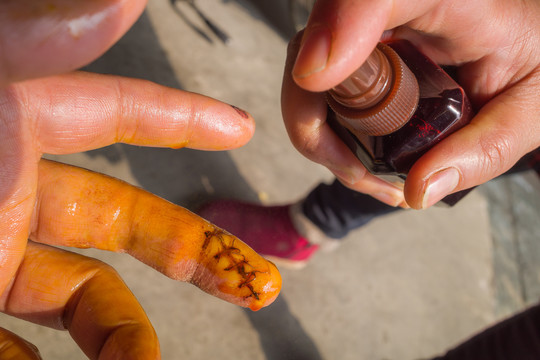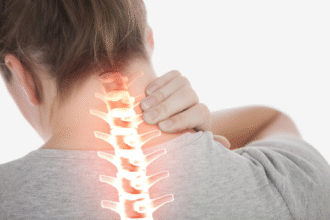Tetanus
Tetanus is a toxin‑mediated neurologic disease caused by Clostridium tetani spores entering a wound, germinating under anaerobic conditions, and releasing tetanospasmin. The toxin blocks inhibitory neurotransmission, producing painful generalized muscle rigidity and reflex spasms that can impair ventilation and autonomic stability. Natural infection does not confer immunity—vaccination is essential even after recovery.
Pathogen & Pathogenesis
- C. tetani: anaerobic, spore‑forming, Gram‑positive bacillus widely present in soil, dust, animal and human feces.
- Spores enter through contaminated wounds (even trivial punctures, splinters, injection sites, burns, necrotic or ischemic tissue, postpartum/ post‑abortion sites, umbilical stump in neonates).
- Favorable conditions: devitalized tissue, foreign bodies, low oxygen tension, co‑infection consuming oxygen.
- Tetanospasmin (neurotoxin) travels retrograde along motor axons to the CNS and trans‑synaptically to inhibitory interneurons, cleaving synaptobrevin (VAMP), blocking release of GABA and glycine → unchecked excitatory discharge → rigidity and spasms.
- Shorter incubation (often <7 days) correlates with higher inoculum and worse prognosis.
Incubation & Period of Onset
- Incubation: 3–21 days (median ~7–10); may be hours to months (rare foreign‑body cases).
- Period of onset: time from first symptom (e.g., trismus) to first generalized spasm; short onset (<48 h) signals severe disease.
Clinical Forms
- Generalized (most common): trismus (lockjaw), risus sardonicus (sardonic grin), neck stiffness, dysphagia, board‑like abdominal rigidity, opisthotonos, painful triggered spasms (noise, touch, light), autonomic instability (labile hypertension, tachycardia, sweating, arrhythmias).
- Localized: rigidity near wound; may progress to generalized.
- Cephalic: cranial nerve palsies (often following head injury or otitis media) plus trismus; high risk of generalization.
- Neonatal: infection via contaminated umbilical stump (poor cord hygiene); presents days 3–7 with poor feeding, rigidity, spasms; very high mortality.
- Late or chronic: rare, prolonged mild rigidity.
Differential Diagnosis
Meningitis, strychnine poisoning (quicker onset, clear sensorium, no trismus early), hypocalcemic tetany, dystonic reactions, malignant neuroleptic syndrome, serotonin syndrome, rabies (aerophobia/hydrophobia), stiff‑person spectrum disorders, severe tetany from electrolyte disturbance.
Diagnosis
- Primarily clinical (no routine lab confirmation). Wound cultures often negative and not required.
- Consider in any patient with painful muscle rigidity and spasms (especially trismus) without alternative explanation and incomplete vaccination history.
Severity Indicators
- Short incubation (<7 days) or short period of onset (<48 h).
- Early autonomic dysfunction, frequent severe spasms, sustained tachycardia.
- Neonatal or cephalic forms.
Emergency Management (Core Principles)
- Neutralize unbound toxin: Human Tetanus Immune Globulin (TIG) 3000–6000 IU IM (single dose; infiltrate around wound if feasible). IVIG is an alternative if TIG unavailable (dose varies; consult guidelines).
- Control source & prevent further toxin production: meticulous wound debridement + antibiotics (metronidazole IV/PO typically preferred; penicillin G acceptable though may theoretically worsen inhibitory neurotransmission—clinical significance minimal).
- Control muscle rigidity/spasms:
- First line: benzodiazepines (e.g., diazepam, midazolam infusion) for sedation and muscle relaxation.
- Adjuncts: magnesium sulfate (reduces catecholamine release, stabilizes autonomic function), baclofen (especially intrathecal for refractory spasms), neuromuscular blockade with mechanical ventilation for severe uncontrolled spasms.
- Manage autonomic dysfunction: continuous monitoring; magnesium, short‑acting beta‑blockers (esmolol), clonidine, dexmedetomidine; avoid sudden hypotension.
- Airway & ventilation: early intubation if frequent spasms compromise airway or ventilation; tracheostomy in prolonged severe cases.
- Supportive care: quiet, low‑stimulus environment; DVT prophylaxis, nutrition (early enteral feeding), pressure injury prevention, bladder management.
- Vaccination: start/continue tetanus vaccination series (e.g., Tdap followed by Td/Tdap at 4–8 weeks and 6–12 months) because disease does not confer immunity.
Antibiotic Regimens (Typical)
- Metronidazole 500 mg IV/PO every 6–8 h (7–10 days) OR
- Penicillin G 2–4 million units IV every 4–6 h (if metronidazole contraindicated).
- Add broad coverage only if polymicrobial traumatic wound suspected.
Complications
Respiratory failure, aspiration pneumonia, rhabdomyolysis, fractures (vertebral, long bone) from spasms, pressure ulcers, venous thromboembolism, autonomic crises (arrhythmias, extreme BP swings), nosocomial infections.
Prognosis
Mortality higher with extremes of age, delayed treatment, short incubation/onset period, and lack of advanced critical care. Recovery of neuromuscular junction function is gradual (weeks) as new synaptic terminals form.
Prevention
- Primary prevention: age‑appropriate vaccination (DTaP/Tdap series, adolescent booster, pregnancy booster each gestation 27–36 weeks, Td/Tdap every 10 years thereafter).
- Wound prophylaxis algorithm (simplified):
- Clean, minor wound & completed primary series with booster <10 years: no action.
- Clean, minor wound & last dose ≥10 years: give Td/Tdap booster.
- All other wounds (contaminated, puncture, crush, burn, frostbite, avulsion) & last dose ≥5 years: give booster.
- Unknown/incomplete vaccination + clean wound: start/continue series.
- Unknown/incomplete vaccination + contaminated/high‑risk wound: TIG + start series.
- Hygienic delivery and cord care prevent neonatal tetanus.
- Harm reduction: sterile injection practices for people who inject drugs.
When to Seek Urgent Care
- New trismus (difficulty opening mouth) after a wound.
- Painful muscle spasms, arching (opisthotonos), difficulty swallowing or breathing.
- Autonomic instability: sudden sweating, racing heart with rigidity.
- In newborns: poor feeding, stiff body, spasms after cord stump manipulation.
Educational information only; suspected tetanus is a medical emergency requiring immediate evaluation, TIG administration, and intensive supportive care.







